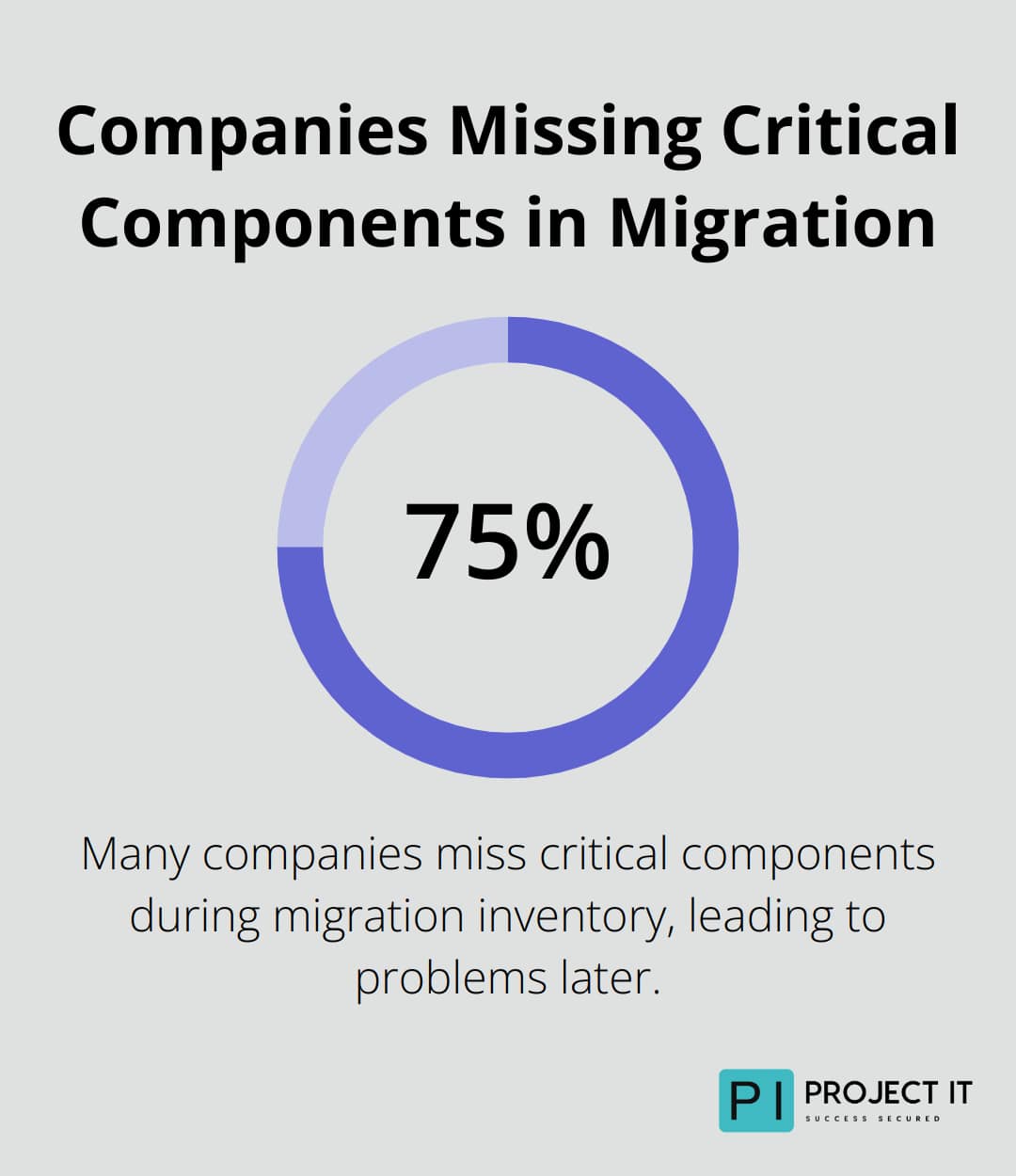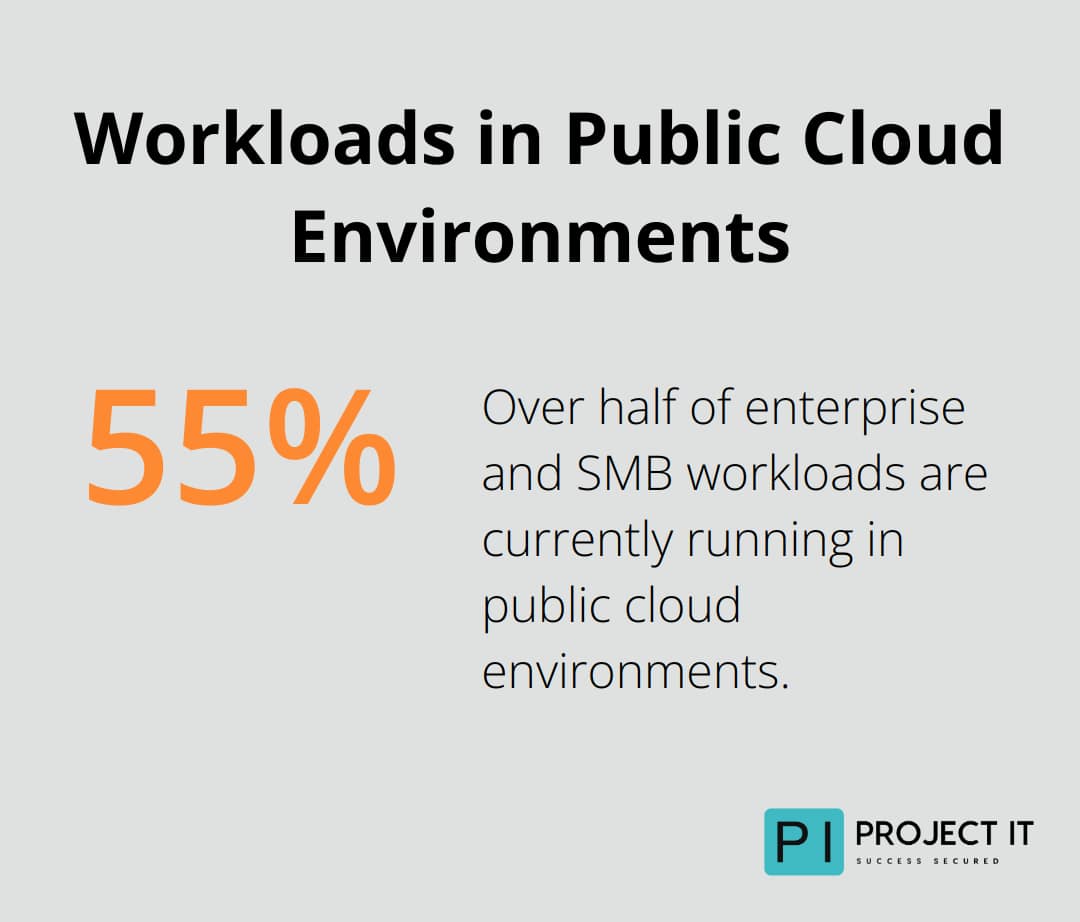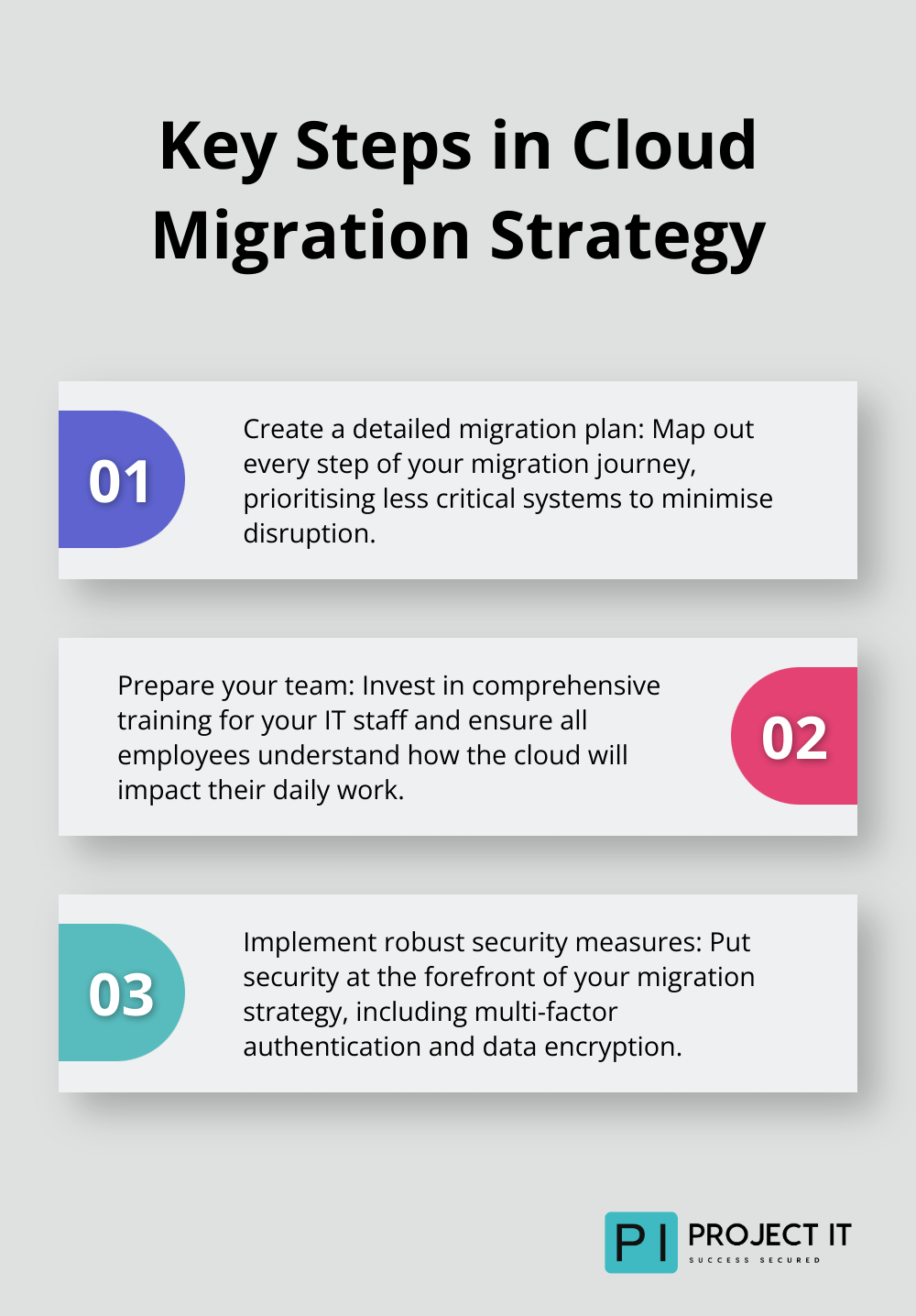Cloud migration is reshaping the business landscape, offering unparalleled flexibility and scalability.
At Project IT, we’ve guided countless organisations through this transformative journey.
This guide will walk you through the essential steps to seamlessly transition your business to the cloud, ensuring you harness its full potential while minimising disruption.
What’s Your Current IT Setup?
Map Out Your Digital Landscape
Start by creating a detailed inventory of your IT assets. List all your applications, databases, and hardware. Don’t overlook those old legacy systems tucked away in the corner. Many companies miss critical components, which can lead to migration problems later.

Next, prioritise your assets. Identify which systems are mission-critical and which ones can be offline for a short period. This prioritisation will guide your migration strategy.
Measure Your Performance
Benchmark your current system performance. Record metrics like response times, uptime, and resource utilisation. These numbers will serve as your baseline for comparing cloud performance later.
Tools like New Relic or Datadog (among others) can help you gather these metrics. They’ll provide a clear picture of your current infrastructure’s strengths and weaknesses.
Define Your Cloud Goals
Think about what you want to achieve with cloud migration. Do you want to cut costs? Improve scalability? Enhance security? Your goals will shape your cloud strategy.
Be specific. Instead of saying “we want to save money,” try to set a target like “we want to reduce our IT infrastructure costs by 30% within the first year of migration.”
Assess Your Team’s Skills
Cloud migration isn’t just about technology – it’s about people too. Evaluate your team’s cloud expertise. Do they have experience with cloud platforms? Are they familiar with containerisation or serverless architectures?
If there are skill gaps, plan for training or consider bringing in cloud experts. Companies often underestimate the learning curve associated with cloud technologies.
Plan for Data Security
Assess your current data security measures and identify areas that need improvement in the cloud. Consider encryption methods, access controls, and compliance requirements (such as GDPR or HIPAA).
A thorough assessment now will prevent issues later. It forms the foundation for a successful cloud migration strategy. The specific strategies and scenarios for cloud adoption and migration depend on the needs of the organisation and its current IT infrastructure.
Which Cloud Service Model Fits Your Business?
Understanding Cloud Service Models
The cloud service model you choose can significantly impact your migration success. Three main models exist: Infrastructure as a Service (IaaS), Platform as a Service (PaaS), and Software as a Service (SaaS).
IaaS provides maximum control and scalability. It offers virtual machines, storage, and networks for you to manage. This model suits businesses that want to move existing applications without major changes. Amazon Web Services (AWS) EC2 exemplifies IaaS.
PaaS streamlines development workflows. It handles the underlying infrastructure while you manage applications and data. Developers who prefer to focus on coding without server maintenance often choose PaaS. Google App Engine represents a popular PaaS platform.
SaaS delivers out-of-the-box solutions with minimal setup. You use software over the internet without infrastructure management. It fits businesses seeking ready-to-use applications. Salesforce stands out as a prime SaaS example.
Evaluating Cloud Providers
The cloud provider market features several key players. AWS, Microsoft Azure, and Google Cloud Platform dominate, but smaller, specialised providers might better suit specific needs.
AWS leads with a significant market share. It offers extensive services but can challenge beginners. Azure holds a substantial portion of the market and integrates well with Microsoft products. Google Cloud excels in data analytics and machine learning.
Considering Multi-Cloud Strategies
A multi-cloud strategy can offer advantages. It helps avoid vendor lock-in and optimises costs. Use of the cloud continues to grow, with over half of enterprise and SMB workloads currently running in public cloud environments.

However, multi-cloud approaches increase complexity and require specialised skills. You must weigh these factors against your business needs and resources.
Assessing Your Specific Requirements
Your choice depends on your unique needs, existing infrastructure, and long-term goals. Consider factors such as:
- Scalability requirements
- Budget constraints
- Compliance needs (e.g., data residency laws)
- Integration with existing systems
Seeking Expert Guidance
Choosing the right cloud service model and provider involves complex decisions. Many businesses benefit from expert advice to navigate these choices. IT consultants can provide valuable insights based on your specific situation and industry best practices.
The next step in your cloud migration journey involves developing a comprehensive strategy. This strategy will outline how you’ll move your applications and data to your chosen cloud environment while minimising disruption to your business operations.
How to Execute a Cloud Migration Strategy

Create a Detailed Migration Plan
Map out every step of your migration journey. Identify which applications and data will move first, second, and so on. Prioritise less critical systems to minimise disruption to your core business operations.
Set realistic timelines for each phase of the migration. While the average time for a full enterprise cloud migration can vary significantly based on your organisation’s size and complexity, it’s important to consider cloud computing statistics when planning your timeline.
Prepare Your Team
Cloud migration presents both a technical and people challenge. Invest in comprehensive training for your IT staff. Cloud Academy is a premier enterprise digital skills platform that can help target skill disparities at organisational and individual levels.
Don’t limit training to just your IT team. Make sure all employees understand how the cloud will impact their daily work. This reduces resistance to change and improves adoption rates.
Implement Robust Security Measures
Put security at the forefront of your migration strategy. Implement multi-factor authentication, encrypt data both in transit and at rest, and use virtual private networks (VPNs) for secure connections.
Regularly audit your cloud environment for vulnerabilities. Take steps to avoid becoming part of breach statistics by ensuring proper security measures are in place.
Migrate in Phases
A phased approach to migration reduces risk and allows for course corrections. Start with non-critical applications to test your processes. This approach also gives your team time to familiarise themselves with the new environment.
Monitor performance closely during each phase. Tools like New Relic or Datadog can help you compare cloud performance to your pre-migration benchmarks. If you notice any issues, address them before moving to the next phase.
Optimise Continuously
Cloud migration is not a one-time event but an ongoing process. Continually optimise your cloud environment post-migration to ensure you get the most value from your investment. Regular reviews and adjustments will help you maintain peak performance and cost-efficiency in your new cloud environment.
For a seamless transition, consider expert guidance through every step of the process, from initial planning to full-scale implementation.
Final Thoughts
Cloud migration offers transformative benefits for businesses of all sizes. Organisations can achieve greater scalability, flexibility, and cost-efficiency through this process. The ability to rapidly adjust resources based on demand allows companies to stay agile in today’s fast-paced market.
Cloud environments often provide enhanced security measures and disaster recovery options. These features safeguard critical data and ensure business continuity. Cloud providers invest heavily in security measures, often surpassing what many organisations can implement on-premises.
At Project IT, we specialise in guiding businesses through their cloud migration journey. Our team of experts can help you develop a tailored strategy and implement robust security measures. We provide ongoing support to optimise your cloud environment, ensuring a smooth and secure transition aligned with your unique business needs.


